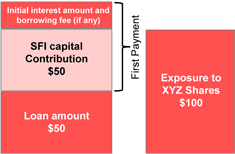A protected loan with no interest payments – Strategies for a rising market (cont.)
Self Funded Instalment Warrants have long been the preferred method of gearing for retirees and SMSFs and offer one of the lower risk ways to gear your portfolio.
Self Funded Instalment Warrants are a combination of a loan, your deposit and an insurance policy (put option) used to purchase shares.
The benefit to investors is that they only need to fund 50%-60% of the purchase price, the remaining 40%-50% is borrowed from the provider, the ongoing interest and insurance premium are covered by the dividends paid with any excess being used to pay down the loan amount.
Benefits include:
Greater potential returns.Since SFIs provide you with around twice as much exposure as your deposit payment, your potential gains are also doubled.
Borrow to invest without having to make annual interest payments. The annual interest costs are typically covered by the dividends with any franking credits received directly by the investor when they lodge their personal tax return.
Gain potential tax benefits. Investors benefit from the passing through of franking credits, providing a tax advantage for many investors greater than what they could achieve on their own equity.
Use gearing without the risk of margin calls. If the shares fall in value, the put option/insurance kicks in and ensures that the loan is paid off allowing the investor to walk away without further recourse.
Unlock equity without selling shares and avoid triggering a capital gain. By converting your existing portfolio of shares to SFIs you can free up cash, whilst still maintaining exposure to the shares you originally owned. At maturity investors can also elect to repay the loan in full and take full legal title of the securities or roll them over to a new instalment.
The re-emergence of SFI’s
If you are familiar with SFI’s you will have noted that these were no longer being offered during the GFC as the increase in uncertainty throughout the GFC meant that the cost of the put option insurance soared, making these products unviable.
Now that share price volatility is around its lowest point since the mid 90’s, SFI’s seem set to re-emerge as the gearing option of choice for investors with limited downside. Westpac have recently launched a SFI offering and we wouldn’t be surprised to see other providers such as Macquarie follow suit in the near future.
Although the in-built insurance (put option) provides additional security should the share price fall below the outstanding loan amount, the cost of put protection is a non-deductible expense and our current preference remains RBS’s offering. Unlike other SFI providers, their product does no contain a put option. Their SFI offers protection to investors by maintaining a stop loss at approximately 10% above the outstanding loan balance, avoiding the need to fund insurance.
Example pricing of RBS Self Funded Instalment Warrants – 22nd February 2011

Feature on Margin Lending

Comment: